Friday, December 29, 2006
An amazing race video
So you've taken your Porsche 996 GT3 out to a track day. You're dicing with an Aston Martin, when suddenly... well, you'll just have to see the video for yourself to see what else joins the fray. It's one of the funniest racetrack videos I've seen.
Labels: Cool Cars
Thursday, December 28, 2006
Pictures and tips from the Dart buildup
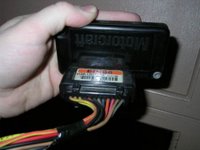 Went to Pull-A-Part today. I brought back a Ford EDIS-6 ignition controller. The cashier couldn't figure out exactly what category this thing fell into, and as it's not much larger than a pack of cards, decided to only charge me about $5. For a six cylinder version, look for a '90 or later Aerostar; you'll find it on the passenger side inner front fender if a fellow scavenger hasn't already taken it.
Went to Pull-A-Part today. I brought back a Ford EDIS-6 ignition controller. The cashier couldn't figure out exactly what category this thing fell into, and as it's not much larger than a pack of cards, decided to only charge me about $5. For a six cylinder version, look for a '90 or later Aerostar; you'll find it on the passenger side inner front fender if a fellow scavenger hasn't already taken it.This handy little module is one of the simpler ways to set up a distributorless ignition with Megasquirt. You'll need a module, a trigger wheel with its sensor, a coil pack, the associated wiring connectors, and the Megasquirt. You can use a Megasquirt-I with a few mods, or Megasquirt-II with hardly any changes at all. When you're using EDIS, you absolutely must use a 36 toothed crank wheel with one tooth missing - this requirement is hardwired into the EDIS module.
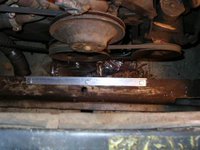 I've been making some progress on the radiator brackets for the Dart. Griffin didn't supply brackets with it, and the Summit brackets, in unmodified form, don't look like they were designed for a Mopar A-body. After all, this radiator was mostly meant for low buck circle track racers and not street cars. The lower mount is simply a piece of 1" angle alumium about 1/8" thick, held in place by three bolts. I added a foam rubber neoprene strip to the raised edge, too. I located it by putting the radiator in place and tracing its lower edge with an industrial-type crayon. Pretty simple but effective.
I've been making some progress on the radiator brackets for the Dart. Griffin didn't supply brackets with it, and the Summit brackets, in unmodified form, don't look like they were designed for a Mopar A-body. After all, this radiator was mostly meant for low buck circle track racers and not street cars. The lower mount is simply a piece of 1" angle alumium about 1/8" thick, held in place by three bolts. I added a foam rubber neoprene strip to the raised edge, too. I located it by putting the radiator in place and tracing its lower edge with an industrial-type crayon. Pretty simple but effective.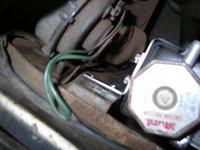 I'm using the Summit brackets to anchor it on the top side. Only I've made a few changes to them by drilling out the bottom and bolting on some simple L-brackets from Ace Hardware. I'm using U-nuts on the radiator support to hold it in place so that I'll be able to unbolt the radiator without taking the grille off to hold the nuts from the other side. In this picture, I'm just test fitting it, so not all the bolts are fully tightened and not all the U-nuts are in place. Once I get the slots cut for all the U-nuts, the only brackets left will be the ones for the intercooler.
I'm using the Summit brackets to anchor it on the top side. Only I've made a few changes to them by drilling out the bottom and bolting on some simple L-brackets from Ace Hardware. I'm using U-nuts on the radiator support to hold it in place so that I'll be able to unbolt the radiator without taking the grille off to hold the nuts from the other side. In this picture, I'm just test fitting it, so not all the bolts are fully tightened and not all the U-nuts are in place. Once I get the slots cut for all the U-nuts, the only brackets left will be the ones for the intercooler.I think I know how I'll set that one up now, too, after a bit of test fitting. I plan to take a larger piece of angle aluminum, maybe 3" or so on each side, and run it across the radiator support out in front. This will support the intercooler from below - I may duplicate this for the top support, or I may use a simpler system up there as the lower bracket will take most of the weight. Ace Hardware doesn't carry angle aluminum that big, but I know I can get it from McMaster-Carr. Industrial supply houses have a lot of potential speed parts if you know where to look.
Labels: Dodge Dart
Tuesday, December 26, 2006
An open letter to the Federal Trade Commission
I've blogged about companies that make dubious claims about improving gas mileage. I've talked about them on message boards. I really don't like it when unscrupulous manufacturers take advantage of people's ignorance about cars and anxiety over high gas prices. Well, now, I've decided to do something else about it.
Did you know that the Federal Trade Commission has the power to compell any company making something they claim improves gas mileage to submit it to the EPA for testing? When that happens, the EPA publishes their results online for the world to see. And I'd like to see them do that to the makers of the Turbonator, SpiralMax, Vortec Cyclone, Tornado Fuel Saver, and the whole collection of scum trying to promote "superchargers" with no moving parts.
I'm sending a letter to the FTC today urging them to look into this. And I would appreciate it if you, the readers, would also take action to make these people put up (their test results) or shut up. Here is the letter I am sending the FTC.
Federal Trade Commission
CRC-240
Washington, DC 20580
Dear Federal Trade Commission:
I am writing to you to complain about an automotive device that I believe to be a scam. It's been around for many years, but recently the people who sell it have made a much more aggressive push, getting it displayed in large display cases at Pep Boys and other auto parts stores. This product goes by several brand names, including Tornado Fuel Saver, SpiralMax, Vortec Cyclone, and Turbonator. The companies selling this often make claims that range from misleading to completely false, and I've seen several tests by news media and private citizens where it failed to produce the promised improvements in horsepower and gas mileage. Here are some examples of false claims:
First, the devices claim to be superchargers. Spiralmax and Vortec Cyclone both use “Supercharge any car” as their slogan, and Turbonator's website promises that their product allows you to “Supercharge your car, truck, van, boat, RV, or motorcycle in just a few minutes.” A supercharger is a power-driven air compressor installed in an engine's air intake. These devices are not power-driven, and do not resemble or function as an air compressor or pump in any way.
Second, these devices all claim to improve gas mileage. Vortec Cyclone's manufacturers claim, “The average user experiences a 1-2 MPG improvement in fuel economy; some users have experienced up to a 30% increase in mileage.” Tornado Fuel Saver claims, “TornadoFuelSaver increases gas mileage anywhere from 7-15%.” Turbonator claims, “Turbonator users have reported MPG increases from 10 to 22 percent,” and SpiralMax claims, “You get more torque, acceleration, and better fuel economy.” However, tests by Popular Mechanics (in their September 2005 issue) and CNN found such devices produced anywhere from no effect on fuel mileage, to a 10% drop in fuel mileage. I have never seen an independent test under controlled conditions where any one of these four devices has produced an improvement in fuel economy.
Third, they claim to provide improvements in horsepower, sometimes as much as 35 hp or 35% more power. I have seen the results of several people subjecting these to dynamometer tests, and every time it has been tested in this manner, installing the device caused the engine to lose horsepower instead of gain power. One of the results, where a truck lost 10% of its horsepower, was published in the September 2005 issue of Popular Mechanics; another test appeared on CNN.com with similar results.
They are marketed with several other dubious claims. Many of them claim to produce more “swirl” in the combustion chamber, but are installed upstream of a flat throttle blade and between one and two feet of plumbing where the air must execute several turns, branch off into individual cylinder runners, and pass through the intake valves. It is doubtful that any swirl effect created by this device could sustain itself long enough through the intake to produce any meaningful results in combustion.
I am writing to request that the FTC take action against the manufacturers and marketers of these devices. Every independent, scientific test I have seen of such devices has shown that they do not perform according to the manufacturers' claims. I would like to see these companies forced to submit their devices to EPA testing to determine if there is any basis in fact for these claims.
I have not bought one of these myself, but if you need for me to test one personally to have a basis for filing a complaint, I would be glad to purchase one, install it on one of my personal vehicles, and have it tested on a dynamometer to see if it causes my car to lose horsepower – as I suspect it will.
Here are the addresses of the companies marketing these products:
Tornado Fuel Saver
1182 Hyde Park Dr.
Santa Ana, CA 92705
The Vortec Cyclone's manufactures do not give their physical address out on the company website, but they may be found online at http://www.vorteccyclone.com/index.html.
Turbonator
6747 Land O Lakes Blvd.
Land O Lakes, Florida, 34638
SpiralTech USA, Inc. - JT&T Mfg, Inc. (SpiralMax)
111 W. Fairview Avenue
San Gabriel, CA 91776
Thank you for your time.
Sincerely,
Matthew Cramer
If you'd like to lobby the government to have one of these things tested, the address is right there at the top of my letter. While it might not be effective to copy my letter verbatim (they might think I was a Mad Xeroxer, sending in dozens of the same letter), feel free to use it as a template. If you've been ripped off, be sure to mention your experience in your letter. You may also contact Steve Johnson, the EPA Administrator, who also has the authority to force the manufacturers to submit their products to EPA testing. I believe this address is the correct one to reach him:
Steve Johnson
U.S. Environmental Protection Agency
Ariel Rios Building
1200 Pennsylvania Avenue, N.W.
Washington, DC 20460
If you believe these manufacturers are innocent, that these products actually work, I'd urge you to contact the FTC and EPA too, and ask for these to be tested. Why? Well, for one thing, that'll shut me up about them! I will issue an apology to these companies in the unlikely event that an EPA test reveals their products actually work. And if they work, you shouldn't have anything to fear from what I'm proposing, should you?
Did you know that the Federal Trade Commission has the power to compell any company making something they claim improves gas mileage to submit it to the EPA for testing? When that happens, the EPA publishes their results online for the world to see. And I'd like to see them do that to the makers of the Turbonator, SpiralMax, Vortec Cyclone, Tornado Fuel Saver, and the whole collection of scum trying to promote "superchargers" with no moving parts.
I'm sending a letter to the FTC today urging them to look into this. And I would appreciate it if you, the readers, would also take action to make these people put up (their test results) or shut up. Here is the letter I am sending the FTC.
Federal Trade Commission
CRC-240
Washington, DC 20580
Dear Federal Trade Commission:
I am writing to you to complain about an automotive device that I believe to be a scam. It's been around for many years, but recently the people who sell it have made a much more aggressive push, getting it displayed in large display cases at Pep Boys and other auto parts stores. This product goes by several brand names, including Tornado Fuel Saver, SpiralMax, Vortec Cyclone, and Turbonator. The companies selling this often make claims that range from misleading to completely false, and I've seen several tests by news media and private citizens where it failed to produce the promised improvements in horsepower and gas mileage. Here are some examples of false claims:
First, the devices claim to be superchargers. Spiralmax and Vortec Cyclone both use “Supercharge any car” as their slogan, and Turbonator's website promises that their product allows you to “Supercharge your car, truck, van, boat, RV, or motorcycle in just a few minutes.” A supercharger is a power-driven air compressor installed in an engine's air intake. These devices are not power-driven, and do not resemble or function as an air compressor or pump in any way.
Second, these devices all claim to improve gas mileage. Vortec Cyclone's manufacturers claim, “The average user experiences a 1-2 MPG improvement in fuel economy; some users have experienced up to a 30% increase in mileage.” Tornado Fuel Saver claims, “TornadoFuelSaver increases gas mileage anywhere from 7-15%.” Turbonator claims, “Turbonator users have reported MPG increases from 10 to 22 percent,” and SpiralMax claims, “You get more torque, acceleration, and better fuel economy.” However, tests by Popular Mechanics (in their September 2005 issue) and CNN found such devices produced anywhere from no effect on fuel mileage, to a 10% drop in fuel mileage. I have never seen an independent test under controlled conditions where any one of these four devices has produced an improvement in fuel economy.
Third, they claim to provide improvements in horsepower, sometimes as much as 35 hp or 35% more power. I have seen the results of several people subjecting these to dynamometer tests, and every time it has been tested in this manner, installing the device caused the engine to lose horsepower instead of gain power. One of the results, where a truck lost 10% of its horsepower, was published in the September 2005 issue of Popular Mechanics; another test appeared on CNN.com with similar results.
They are marketed with several other dubious claims. Many of them claim to produce more “swirl” in the combustion chamber, but are installed upstream of a flat throttle blade and between one and two feet of plumbing where the air must execute several turns, branch off into individual cylinder runners, and pass through the intake valves. It is doubtful that any swirl effect created by this device could sustain itself long enough through the intake to produce any meaningful results in combustion.
I am writing to request that the FTC take action against the manufacturers and marketers of these devices. Every independent, scientific test I have seen of such devices has shown that they do not perform according to the manufacturers' claims. I would like to see these companies forced to submit their devices to EPA testing to determine if there is any basis in fact for these claims.
I have not bought one of these myself, but if you need for me to test one personally to have a basis for filing a complaint, I would be glad to purchase one, install it on one of my personal vehicles, and have it tested on a dynamometer to see if it causes my car to lose horsepower – as I suspect it will.
Here are the addresses of the companies marketing these products:
Tornado Fuel Saver
1182 Hyde Park Dr.
Santa Ana, CA 92705
The Vortec Cyclone's manufactures do not give their physical address out on the company website, but they may be found online at http://www.vorteccyclone.com/index.html.
Turbonator
6747 Land O Lakes Blvd.
Land O Lakes, Florida, 34638
SpiralTech USA, Inc. - JT&T Mfg, Inc. (SpiralMax)
111 W. Fairview Avenue
San Gabriel, CA 91776
Thank you for your time.
Sincerely,
Matthew Cramer
If you'd like to lobby the government to have one of these things tested, the address is right there at the top of my letter. While it might not be effective to copy my letter verbatim (they might think I was a Mad Xeroxer, sending in dozens of the same letter), feel free to use it as a template. If you've been ripped off, be sure to mention your experience in your letter. You may also contact Steve Johnson, the EPA Administrator, who also has the authority to force the manufacturers to submit their products to EPA testing. I believe this address is the correct one to reach him:
Steve Johnson
U.S. Environmental Protection Agency
Ariel Rios Building
1200 Pennsylvania Avenue, N.W.
Washington, DC 20460
If you believe these manufacturers are innocent, that these products actually work, I'd urge you to contact the FTC and EPA too, and ask for these to be tested. Why? Well, for one thing, that'll shut me up about them! I will issue an apology to these companies in the unlikely event that an EPA test reveals their products actually work. And if they work, you shouldn't have anything to fear from what I'm proposing, should you?
Labels: Automotive Awefulness, Gas Mileage
Saturday, December 23, 2006
"It's like I have a brand-new car!"
That was Kelly's impression on driving the Nissan Pathfinder now. It looks like we've fixed the rear suspension issues for good. I took it to Autofab Motorsports (they're right next door to where I work) and they replaced the rear lower control arm bushings with brand new polyurethane bushings. Not only are these a change of material, the design is a bit different, too. Put them next to stock Nissan bushings, and the effect is like having a 2 x 4 next to a Popsicle stick.
I've been pretty impressed with the results. The Pathfinder doesn't fishtail, pull to one side under power, shake, or do that lurch it did when shifting gears under power. And it doesn't seem to have made the suspension any harsher, either - a common complaint with poly bushings. Looks like I've got it cured.
I've been pretty impressed with the results. The Pathfinder doesn't fishtail, pull to one side under power, shake, or do that lurch it did when shifting gears under power. And it doesn't seem to have made the suspension any harsher, either - a common complaint with poly bushings. Looks like I've got it cured.
Labels: Nissan Pathfinder
Tuesday, December 19, 2006
Really useful little online tool
I've seen a few turbo companies that have pages that calculate which one of their product line best fits your engine. Well, I've just found a page that does one better: It can calculate which junkyard turbo best fits your engine, as well as aftermarket ones. You can find it at The Squirrel Performacne Group's turbo calculator. Pretty impressive. You will have to know some details about the turbo, as it goes by turbo model and not car model. The objective is to get the red line to run through the "island" where the turbo is most efficient.
It also tells me that the TE04 on my Dart is way too small.
It also tells me that the TE04 on my Dart is way too small.
Sunday, December 17, 2006
Some overdue picture of the Dart's new intake plumbing
 It's still a work in progress. I've picked up some parts from Ace Hardware to whip up some mounting brackets to go with the Summit parts (not all of them were right for the Dart), and got the knock-off, er, blow-off valve in place. I'm seriously considering whipping up a sticker to put on that valve that parodies the HKS logo.
It's still a work in progress. I've picked up some parts from Ace Hardware to whip up some mounting brackets to go with the Summit parts (not all of them were right for the Dart), and got the knock-off, er, blow-off valve in place. I'm seriously considering whipping up a sticker to put on that valve that parodies the HKS logo.This picture clearly shows the hose I'm using for the intake. It ought to hold up a lot better than the hardware store hose I was running before, as I picked it out of a McMaster-Carr catalog for the purpose (part number 5499K244, if you're looking to use this). Their official description is "Double neoprene coated fiberglass duct hose," and it's a pretty good choice for low buck turbo intake plumbing going by the spec sheet. This hose is rated for 35 psi and 300 degree temperatures - I figure ifI cross either of those lines, it's not likely to be the hose I should be worried about. It forms tight bends. And the ribs are on the outside, unlike with some ribbed intake hose. The only disadvantage I've found so far is that it kinks up when you put a tight bend in it. We'll see how it works in the real world soon.
Labels: Dodge Dart
Tuesday, December 12, 2006
More intercooler installation work
Today, I took the Dart's grille off to make installing the intercooler and radiator a bit easier. I also got started working on the intercooler hose. It looks like I may just not use the Spectre plastic elbows at all, as it seems the flex hose is about what I need. Right now I have the intercooler to throttle body line routed under the battery tray and out the 2.5" hole in the radiator support. I'll see if I can post some pictures tomorrow.
Labels: Dodge Dart
Saturday, December 02, 2006
Starting another round of work on the Dart
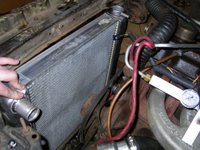 Today I brought the Dart back into the garage and got to work on installing the Griffin radiator and doing something about my jury rigged intake plumbing. The circle track radiator looks like it will be just about the perfect size; I'd measured the stock radiator and found one that was almost the exact same dimensions. It looks like the brackets are meant to mount on the top and bottom of the radiator, rather than side-mounting it. But this should be pretty straightforward. I'll just have to drill a few mounting holes for the brackets, plumb in the external transmission cooler, and get some new radiator hoses as the outlet's not in the same spot. This radiator looks like it ought to be up the task, although being a circle track radiator, the look is more functional than polished. Griffin claims radiators of this size ought to be adequate for 400 hp.
Today I brought the Dart back into the garage and got to work on installing the Griffin radiator and doing something about my jury rigged intake plumbing. The circle track radiator looks like it will be just about the perfect size; I'd measured the stock radiator and found one that was almost the exact same dimensions. It looks like the brackets are meant to mount on the top and bottom of the radiator, rather than side-mounting it. But this should be pretty straightforward. I'll just have to drill a few mounting holes for the brackets, plumb in the external transmission cooler, and get some new radiator hoses as the outlet's not in the same spot. This radiator looks like it ought to be up the task, although being a circle track radiator, the look is more functional than polished. Griffin claims radiators of this size ought to be adequate for 400 hp.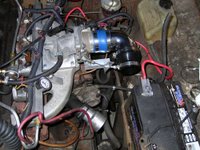
I tore out all of the first effort at intake plumbing except the rubber coupler on the turbo outlet, and I suspect its days are numbered too. It looks like I will need to add a 45 degree elbow on the end of that 90 degree piece. The elbow is a Spectre part that looks like metal; I was a bit disappointed to find that it's actually chrome plated plastic. I had also picked up one of Spectre's "Air Sensor Adapters" that was supposed to work with GM sensors. I'm not sure what sort of GM sensor it's supposed to work with, but it sure isn't the GM intake air temperature sensor with a 3/8" NPT thread like what I have on the Dart. I may just drill that adapter out and thread it, though.
I'll be putting in an intercooler at the same time. I bought some cheap eBay speed parts for that. The parts seem to have been a mixed bag when it comes to quality - many of them are from Communist China, and, well, I've had a few rants about Maoist quality control. But I figured it's hard to make a bad intercooler as long as it doesn't leak, and Jerry has been running one of the HKS blow off valve knock-offs on the DIY Autotune MR2. Of course, after I bought the valve, Jerry then mentioned it has started to have vacuum leak issues.
The intercooler was one I bought from CX Racing, which also seems to be known as Just Intercoolers. They don't seem to have anything to do with racing Honda CX500s. I was pleasantly surprised when I opened the box - this one looks like a pretty well made piece so far. It has a nice polished finish and the welds look pretty good. If anything, it's a bit prettier than the Griffin radiator. Of course, that may just be that they're catering to a different crowd, CX to the show crowd and Griffin to racers in events where their cars often take a real beating.
My impression of the blow-off valve I bought wasn't quite as good. It's a knock-off of the HKS Super Sequential Valve. What I have seen so far isn't encouraging. An HKS valve is made from billet aluminum. That's somewhat overkill and rather pricey, but light and strong. The valve I bought is definitely not billet. It looks as if it's made from cast zinc at first glance, but I think it's simply cast aluminum with some sort of plating on it (An earlier version of this post stated it looked like cast zinc, but I think now there's aluminum under that plating). We'll see if this thing holds up or if I end up pitching it in a trash can and getting a real HKS.
Labels: Dodge Dart

